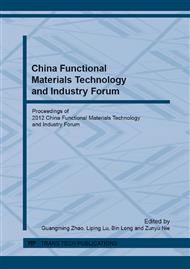[1]
F.J. Morin: Phys. Rev. Lett, Vol. 3 (1959), P. 34.
Google Scholar
[2]
C. Cao, Y. Gao and H. Luo: J. Phys. Chem. C, Vol. 112 (2008), P. 18810.
Google Scholar
[3]
F. Théobald: J. Less Common Met, Vol. 53 (1977), P. 55.
Google Scholar
[4]
C. Leroux, G. Nihoul and G. Van Tendeloo: Phys. Rev. B, Vol. 57 (1978), P. 5111.
Google Scholar
[5]
D. Hagrman, J. Zubieta, C.J. Warren, L.M. Meyer, M.M.J. Treacy and R.C. Haushalter: J: Solid State Chem, Vol. 138 (1998), P. 178.
DOI: 10.1006/jssc.1997.7575
Google Scholar
[6]
J. Ni, W. Jiang, K. Yu, Y. Gao and Z. Zhu: Electrochim. Acta, Vol. 56 (2011), P. 2122.
Google Scholar
[7]
T.D. Manning, I.P. Parkin, M.E. Pemble, D. Sheel and D. Vernardou: Chem. Mater, Vol. 16 (2004), P. 744.
Google Scholar
[8]
G. Xu, P. Jin, M. Tazawa and K. Yoshimura: Sol. Energy Mater. Sol. Cells, Vol. 83 (2004), P. 29.
Google Scholar
[9]
J.M. Wu and L.B. Liou: J. Mater. Chem, Vol. 21 (2011), P. 549.
Google Scholar
[10]
C.B. Greenberg: Thin Solid Films, Vol. 251 (1994), P. 81.
Google Scholar
[11]
B. Hu, Y. Ding, W. Chen, D. Kulkarni, Y. Shen, V.V. Tsukruk and Z.L. Wang: Adv. Mater, Vol. 22 (2010), P. 5134.
Google Scholar
[12]
E. Strelcov, Y. Lilach and A. Kolmakov: Nano Lett, Vol. 9 (2009), P. 2322.
Google Scholar
[13]
C. Wu, X. Zhang, J. Dai, J. Yang, Z. Wu, S. Wei and Y. Xie: J. Mater. Chem, Vol. 21 (2011), P. 4509.
Google Scholar
[14]
S. Ji, Y. Zhao, F. Zhang and P. Jin: J. Cryst. Growth, Vol. 312 (2010), P. 282.
Google Scholar
[15]
L. Whittaker, T.-L. Wu, C.J. Patridge, G. Sambandamurthy and S. Banerjee: J. Mater. Chem, Vol. 21 (2011), P. 5580.
Google Scholar
[16]
L. Whittaker, C. Jaye, Z.G. Fu, D.A. Fischer and S. Banerjee: J. Am.Chem. Soc, Vol. 131 (2009), P. 8884.
Google Scholar
[17]
J.-H. Son, J. Wei, D. Cobden, G. Cao and Y. Xia: Chem. Mater, Vol. 22 (2010), P. 3043.
Google Scholar
[18]
S. Yamamoto, N. Kasai and Y. Shimakawa: Chem. Mater, Vol. 21 (2009), P. 198.
Google Scholar
[19]
G.R. Patzke, Y. Zhou, R. Kontic and F. Conrad: Angew. Chem. Int. Ed., Vol. 50 (2011), P. 826.
Google Scholar
[20]
M. Niederberger, H.-J. Muhr, F. Krumeich, F. Bieri, D. Gunther and R. Nesper: Chem. Mater., Vol. 12 (2000), P. 1995.
Google Scholar
[21]
L.-Q. Mai, W. Chen, Q. Xu, J.-F. Peng and Q.-Y. Zhu: Chem. Phys. Lett, Vol. 382 (2003), P. 307.
Google Scholar
[22]
W. Chen, J. Peng, L. Mai, Q. Zhu and Q. Xu: Mater. Lett, Vol. 58 (2004), P. 2275.
Google Scholar
[23]
M. Li, F. Kong, H. Wang and G. Li: CrystEngComm, Vol. 13 (2011), P. 5317.
Google Scholar
[24]
M. Li, F. Kong, Y. Zhang and G. Li: CrystEngComm, Vol. 13 (2011), P. 2204.
Google Scholar
[25]
M. Li, F. Kong, L. Li, Y. Zhang, L. Chen, W. Yan and G. Li: Dalton Trans, Vol. 40 (2011), P. 10961.
Google Scholar


